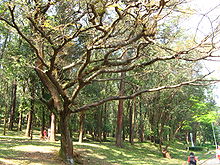Copaifera langsdorffii
| tree | |
|---|---|

| |
| Copaifera langsdorfii in a park in São Paulo Brazil. | |
| Scientific classification | |
| Kingdom: | |
| (unranked): | |
| (unranked): | |
| (unranked): | |
| Order: | |
| Family: | |
| Genus: | |
| Species: | C. langsdorffii
|
| Binomial name | |
| Copaifera langsdorffii | |

The tropical rainforest tree Copaifera langsdorffii is known as the Diesel Tree,[1] Rashed Tree and Salam tree[citation needed]. It has many names in local languages, including kupa'y, cabismo, and copaúva.
Biological description
It is a medium-sized tree usually reaching 12 meters in height, with white flowers and small, oily fruits. The wood is light due to its porosity. And, it is honeycombed with capillaries filled with oil. Tapping the tree involves cutting a well into which the oil seeps and where it can be easily collected. Despite its vigorous production of oil, the tree does not grow well outside of the tropics, and does not show promise as a reliable source of biodiesel in temperate climates.
Uses
Biodiesel use
Wood uses
The wood can be burned for firewood or used in carpentry.
Pollen collector
Bees utilize the tree for pollen collection.[clarification needed]
Medicinal uses
The plant has a great number of historical medicinal uses.[citation needed]
